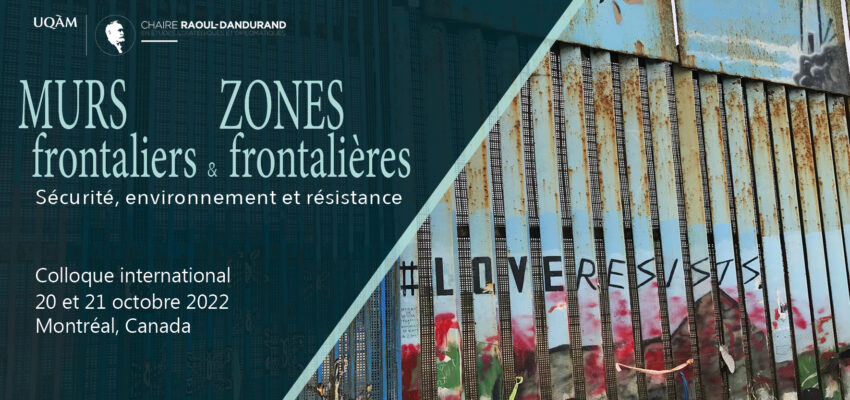

Border Walls and Borderlands - Security, Environment and Resistance
Contact: bordersandwalls@gmail.com
Deadline: Fri, 08 Apr 2022
Border Walls and Borderlands - Security, Environment and Resistance conference will be held in Montreal, Canada (and virtual) on 20-21 October 2022.
The fall of the Berlin Wall and the following redefinition of international relations were meant to signal an age of globalization in which states and sovereignty were to become obsolete and borders irrelevant. However, in the wake of 9/11, borders gained renewed prominence and new ones were drawn. With this trend, border barriers, fences, and walls that were expected to be a historical symbol of a collapsed bipolar system were erected at a pace that defied all predictions. Border barriers are now heavily armoured, cemented, monitored, filmed, and patrolled. In this new environment, walls, razor wire, sensors, helicopters, barriers, (wo)men, border guards and drones have become the accessories of hard borders in an open world, complemented and reinforced by policies oriented towards the double movement of externalization and internalization of borders and the hardening of visa and asylum policies. Furthermore, borders are impacted by ever-evolving technologies. Biotechnologies have become central to border security apparatus. Through the dual process of internalized borders and implementation of biotechnology practices, individuals became security threats and sites of control, reinforcing the individualized experiences of borders. This redefinition of borderlands goes beyond the geographical border zone, impacting the regional system through the modification of political ties, economic relations and socio-cultural exchanges. Transborder flows, both commercial and human, are now front and center in international relations and interstates negotiation. Border walls shape the interaction between states, organizations and individuals.
Border walls, though, trigger quasi automatically a circumvention reflex, from a form of resistance through art, border projects and civil disobedience to the digging of tunnels and smuggling strategies. With their bodies, through their presence, migrants resist as well. Walls simply lead to redrawn migration routes; they don’t deter crossings as shown by data from humanitarian and government agencies. Walls are not impermeable: there are no fortresses, solely control points. Their efficiency lies more within the building country and their power is more symbolic, creating a perception of security in an “Us vs Them” narrative. However, walls do not hold much when migrants fear so much that nothing discourages them anymore, or when the economic disequilibrium between two neighboring countries works as a magnet for underground economy.
Often represented as a way to gain security, border walls also impact daily life in the borderlands, redefining the surroundings and lives of borderland communities, from economic relations to the environment and wildlife. As structures, walls scarify the environment, altering wildlife migration and biodiversity, and increasing urban and rural pollution at a time where impacts of climate change are increasingly visible and tangible. They simultaneously pose threats to conservation efforts in the borderlands, when the wall is constructed in a preserved environment, and a space of opportunities,
when allowing for the expansion of wildlife in buffer zones.
It is now clear that border enforcement, through walls or other forms, has become a normalized response to insecurity. We only need to look at how quickly states closed their borders to all movements in light of the current COVID-19 pandemic. Initially, mobility has been particularly hampered in an unprecedented way for Western populations, where free movement of people was previously taken for granted, while in the Global South, closures added to the insecurities created by limitations of response to the health crisis and threaten circular movements, especially in the world of agriculture and care. As borders started to reopen, unevenness marked the process, further highlighting disparities within a global pandemic.
Border walls redefine borderlines around the world, sealing and hardening what used to be porous soft borders. Thus, if globalization is blurring borders, walls emphasize them. These infrastructures need to be assessed in terms of efficiency, economic, environmental and humane costs. Why build border barriers if they do not solve the issues they have been erected for? What should be done instead? How will borders be conceptualized, lived and experienced after the pandemic? What is the role of academia and border scholars? And where does civil society come in? Border walls’ tangible impact on local societies, economies, and ecosystems, on world migrations, on national policies will be assessed too.
DEADLINE FOR SUBMISSION: 8 April 2022
Please note that papers may be considered for panel sessions, roundtables and poster sessions. Students are encouraged to submit a proposal.
FIELDS: Political Science, Geography, Anthropology, Sociology, Law, Economics, Art, Design, Biology, Environmental Studies, Area Studies, Gender studies, Zoology, Medical studies (this list is intended to be suggestive rather than inclusive).
LANGUAGES:
Proposals can be submitted in French, English and Spanish. However, the conference will be held in English and French.
CONFERENCE THEMES
Theme 1. Impacts of border walls
Theme 2. Legal aspects of border walls
Theme 3. Costs and economies of border walls
Theme 4. Violence of border walls
Theme 5. Alternatives to border walls
Theme 6. Border walls and borderlands
Theme 7. Border walls and international relations/regional systems
Theme 8. Biotechnology, biopolitics and walls
Theme 9. Borders, barriers and the COVID-19 pandemic











